Beko BDSA250K2S LH User manual
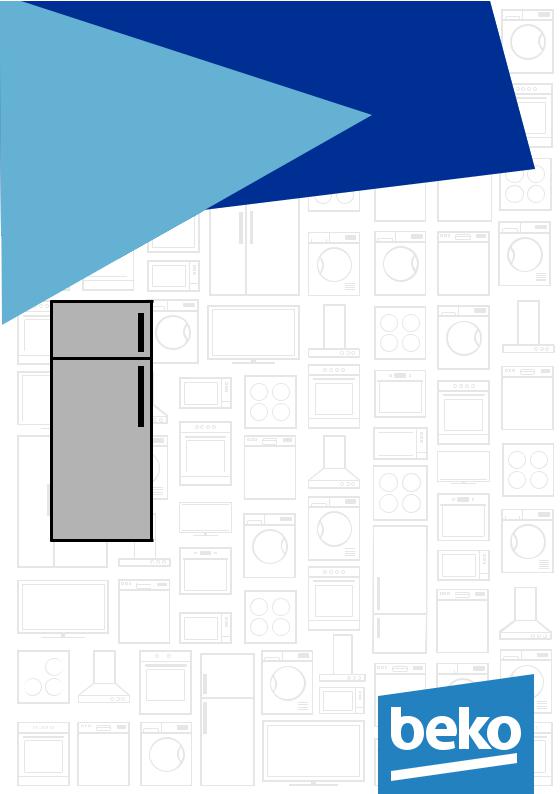
Refrigerator
Frigorifero
Kühlschrank / Gefrierschrank
Congélateur / Réfrigérateur
Refrigerador
Hladilnik

 Koelkast
Koelkast
Instruction of use
Istruzioni per l'uso
Gebrauchsanweisung
Notice d'utilisation
Instrucciones para el uso
Navodila za uporabo
Gebruiksaanwijzing
BDSA250K2S LH
 EN | IT | DE
EN | IT | DE |
| FR | ES | SL | NL
FR | ES | SL | NL
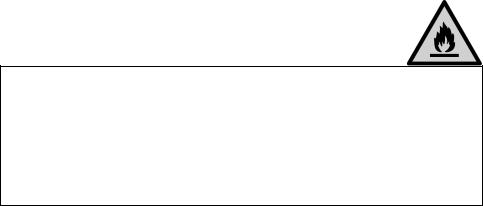
Please read this manual first!
Dear Customer,
We hope that your product, which has been produced in modern plants and checked under the most meticulous quality control procedures, will provide you an effective service.
For this, we recommend you to carefully read the entire manual of your product before using it and keep it at hand for future references.
This manual
•Will help you use your appliance in a fast and safe way.
•Read the manual before installing and operating your product.
•Follow the instructions, especially those for safety.
•Keep the manual in an easily accessible place as you may need it later.
•Besides, read also the other documents provided with your product. Please note that this manual may be valid for other models as well.
Symbols and their descriptions
This instruction manual contains the following symbols:
C
A Warning against dangerous conditions for life and property. B Warning against electric voltage.
WARNING!
In order to ensure a normal operation of your refrigerating appliance, which uses |
|
a completely environmentally friendly refrigerant the R600a (flammable only |
|
under certain conditions) you must observe the following rules: |
|
• |
Do not hinder the free circulation of the air around the appliance. |
• |
Do not use mechanical devices in order to accelerate the defrosting, |
• |
others than the ones recommended by the manufacturer. |
Do not destroy the refrigerating circuit. |
|
• |
Do not use electric appliances inside the food keeping compartment, other |
|
than those that might have been recommended by the manufacturer. |

CONTENTS
1 Your refrigerator |
3 |
2 Important Safety Warnings 4 |
|
Intended use...................................... |
4 |
General safety ................................... |
4 |
For products with a water dispenser..6 |
|
Child safety........................................ |
6 |
Compliance with WEEE Directive and |
|
Disposing of the Waste Product: ....... |
6 |
Compliance with RoHS Directive: ...... |
6 |
Package information.......................... |
6 |
HCA Warning .................................... |
6 |
Things to be done for energy saving ..6 |
|
Preparation |
10 |
5 Using your refrigerator |
11 |
Thermostat setting button................ |
11 |
Cooling............................................ |
11 |
Freezing........................................... |
11 |
Defrost ............................................ |
11 |
Stopping your product..................... |
12 |
Ice making........................................ |
12 |
Maintenance and |
|
cleaning |
13 |
Protection of plastic surfaces .......... |
13 |
Installation |
7 |
Points to be considered when re- |
|
transporting your refrigerator ............. |
7 |
Before operating your refrigerator ...... |
7 |
Electric connection ............................ |
7 |
Disposing of the packaging ............... |
8 |
Disposing of your old refrigerator ....... |
8 |
Placing and Installation ...................... |
8 |
Replacing the interior light bulb ......... |
8 |
Reversing the doors .......................... |
9 |
Recommended solutions |
|
for the problems |
14 |
2EN

1 Your refrigerator
9
10
9
11
1.Freezer shelf
2.Light bulb and thermostat box
3.Fridge compartment shelves
4.Wine rack
5.Defrost water collection channel
-drain tube
6.Crisper cover
7.Salad crisper
12
1
2
3
4
3
13
3
5
6
7
8
8.Front feet
9.Door shelves
10.Egg tray
11.Bottle shelf
12.Freezer compartment
13.Fridge compartment
C Figures that take place in this instruction manual are schematic and may not correspond exactly with your product. If the subject parts are not included in
the product you have purchased, then it is valid for other models.
3EN

2 Important Safety Warnings
Please review the following information. Failure to observe this information may cause injuries or material damage.
Otherwise, all warranty and reliability commitments will become invalid.
Original Spare parts will be provided for 10 years, following the product purchasing date.
Intended use
This product is intended to be used:
•indoors and in closed areas such as homes;
•in closed working environments such as stores and offices;
•in closed accommodation areas such as farm houses, hotels, pensions.
•This product should not be used outdoors.
General safety
•When you want to dispose/scrap the product, we recommend you to consult the authorized service in order to learn the required information and authorized bodies.
•Consult your authorized service for all your questions and problems related to the refrigerator. Do not intervene or let someone intervene to the refrigerator without notifying the authorised services.
•For products with a freezer compartment; Do not eat cone ice cream and ice cubes immediately after you take them out of the freezer compartment! (This may cause frostbite in your mouth.)
•For products with a freezer compartment; Do not put bottled and canned liquid beverages in the freezer compartment. Otherwise, these may burst.
•Do not touch frozen food by hand; they may stick to your hand.
•Vapor and vaporized cleaning materials should never be used in cleaning and defrosting processes of your refrigerator. In such cases, the vapor may get in contact with the electrical parts and cause short circuit or electric shock.
•Unplug your refrigerator before cleaning or defrosting.
•Never use the parts on your refrigerator such as the door as a means of support or step.
•Do not use electrical devices inside the refrigerator.
•Do not damage the parts, where the refrigerant is circulating, with drilling or cutting tools. The refrigerant that might blow out when the gas channels of the evaporator, pipe extensions or surface coatings are punctured causes skin irritations and eye injuries.
•Do not cover or block the ventilation holes on your refrigerator with any material.
•Electrical devices must be repaired by only authorised persons. Repairs performed by incompetent persons create a risk for the user.
•In case of any failure or during a maintenance or repair work,
disconnect your refrigerator’s mains supply by either turning off the relevant fuse or unplugging your appliance.
•Do not pull by the cable when pulling off the plug.
•Place the beverage with higher proofs tightly closed and vertically.
•Never store spray cans containing flammable and explosive substances in the refrigerator.
•Do not use mechanical devices or other means to accelerate the
defrosting process, other than those recommended by the manufacturer.
4EN

•This product is not intended to be used by persons with physical, sensory or mental disorders or unlearned or inexperienced people (including children) unless they are attended by a person who will be responsible for their safety or who will instruct them accordingly for use of the product.
•Do not operate a damaged refrigerator. Consult with the service agent if you have any concerns.
•Electrical safety of your refrigerator shall be guaranteed only if the earth system in your house complies with standards.
•Exposing the product to rain, snow, sun and wind is dangerous with respect to electrical safety.
•Contact authorized service when there is a power cable damage to avoid danger.
•Never plug the refrigerator into the wall outlet during installation. Otherwise, risk of death or serious injury may arise.
•This refrigerator is intended for only storing food items. It must not be used for any other purpose.
•Label of technical specifications is located on the left wall inside the refrigerator.
•Never connect your refrigerator to electricity-saving systems; they may damage the refrigerator.
•If there is a blue light on the refrigerator, do not look at the blue light with optical tools.
•For manually controlled refrigerators, wait for at least 5 minutes to start the refrigerator after power failure.
•This operation manual should be handed in to the new owner of the product when it is given to others.
•Avoid causing damage on power cable when transporting the refrigerator. Bending cable may cause fire. Never place heavy objects on power cable. Do not touch the plug with wet hands when plugging the product.
•Do not plug the refrigerator if the wall outlet is loose.
•Water should not be sprayed directly on inneror outer parts of the product for safety purposes.
•Do not spray substances containing inflammable gases suchas propane gas near the refrigerator to avoid fire and explosion risk.
•Never place containers filled with water on top of the refrigerator, otherwise this may cause electric shock or fire.
•Do not overload your refrigerator with excessive amounts of food. If overloaded, the food items may fall down and hurt you and damage refrigerator when you open the door.
•Never place objects on top of the refrigerator; otherwise, these objects may fall down when you open or close the refrigerator's door.
•As they require a precise temperature, vaccines, heat-sensitive medicine and scientific materials and etc. should not be kept in the refrigerator.
•If not to be used for a long time, refrigerator should be unplugged. A possible problem in power cable may cause fire.
•The plug’s tip should be cleaned regularly with a dry cloth; otherwise, it may cause fire.
•Refrigerator may move if adjustable legs are not properly secured on the floor. Properly securing adjustable legs on the floor can prevent the refrigerator to move.
•When carrying the refrigerator, do not hold it from door handle. Otherwise, it may be snapped.
•When you have to place your product next to another refrigerator or freezer, the distance between devices should be at least 8 cm. Otherwise, adjacent side walls may be humidified.
5EN

For products with a water dispenser;
Pressure of water mains should be minimum 1 bar. Pressure of water mains should be maximum 8 bars.
• Use only potable water.
Child safety
•If the door has a lock, the key should be kept away from reach of children.
•Children must be supervised to prevent them from tampering with the product.
Compliance with WEEE Directive and Disposing of the Waste Product:
This product complies with EU WEEE Directive (2012/19/EU). This
product bears a
classification symbol for waste electrical and electronic equipment
(WEEE). This product has been manufactured with high quality parts and
materials which can be reused and are suitable for recycling. Do not dispose of the waste product with normal domestic and other wastes at the end of its service life. Take it to the collection center for the recycling of electrical and electronic equipment. Please consult your local authorities to learn about these collection centers.
Compliance with RoHS Directive:
The product you have purchased complies with EU RoHS Directive (2011/65/EU). It does not contain harmful and prohibited materials specified in the Directive.
Package information
Packaging materials of the product are manufactured from recyclable materials in accordance with our National Environment Regulations. Do not dispose of the packaging materials together with the domestic or other wastes. Take them to the packaging material collection points designated by the local authorities.
HCA Warning
If your product's cooling system contains R600a:
This gas is flammable. Therefore, pay attention to not damaging the cooling system and piping during usage and transportation. In the event of damage, keep your product away from potential fire sources that can cause the product catch a fire and ventilate the room in which the unit is placed.
Ignore this warning if your product's cooling system contains R134a.
Type of gas used in the product is stated in the type plate which is on the left wall inside the refrigerator.
Never throw the product in fire for disposal.
Things to be done for energy saving
•Do not leave the doors of your refrigerator open for a long time.
•Do not put hot food or drinks in your refrigerator.
•Do not overload your refrigerator so that the air circulation inside of it is not prevented.
•Do not install your refrigerator under direct sunlight or near heat emitting appliances such as ovens, dishwashers or radiators.
•Pay attention to keep your food in closed containers.
•For products with a freezer compartment; You can store maximum amount of food items in the freezer when you remove the shelf or drawer of the freezer. Energy consumption value stated for your refrigerator has been determined by removing freezer shelf or drawer and under maximum load. There is no harm to use a shelf or drawer according to the shapes and size of food to be frozen.
•Thawing frozen food in fridge compartment will both provide energy saving and preserve the food quality.
6EN

3 Installation
BPlease remember that the manufacturer shall not be held liable if the information given in the instruction manual is not observed.
Points to be considered when re-transporting your refrigerator
1.Your refrigerator must be emptied and cleaned prior to any transportation.
2.Shelves, accessories, crisper and etc. in your refrigerator must be fastened
securely by adhesive tape against any jolt before repackaging.
3. Packaging must be tied with thick tapes and strong ropes and the rules of transportation printed on the package must be followed.
Please do not forget…
Every recycled material is an indispensable source for the nature and for our national resources.
If you wish to contribute to recycling the packaging materials, you can
get further information from the environmental bodies or local authorities.
Before operating your refrigerator
Before starting to use your refrigerator check the following:
1.Is the interior of the refrigerator dry and can the air circulate freely in the rear of it?
2.Clean the interior of the refrigerator as recommended in the
“Maintenance and cleaning” section.
3.Plug the refrigerator into the wall outlet. When the fridge door is open, the fridge compartment interior light will come on.
4.You will hear a noise as the compressor starts up. The liquid and gases sealed within the refrigeration system may also give rise to noise, even if the compressor is not running and this is quite normal.
5.Front edges of the refrigerator may feel warm. This is normal. These areas are designed to be warm to avoid condensation
Electric connection
Connect your product to a grounded socket which is being protected by a fuse with the appropriate capacity.
Important:
•The connection must be in compliance with national regulations.
•The power cable plug must be easily accessible after installation.
•The specified voltage must be equal to your mains voltage.
•Extension cables and multiway plugs must not be used for connection.
BA damaged power cable must be replaced by a qualified electrician.
BProduct must not be operated before it is repaired! There is danger of electric shock!
7EN

Disposing of the packaging
The packing materials may be dangerous for children. Keep the packing materials out of the reach of children or dispose of them by classifying them in accordance with the waste instructions. Do not dispose of them along with the normal household waste.
The packing of your refrigerator is produced from recyclable materials.
Disposing of your old refrigerator
Dispose of your old refrigerator without giving any harm to the
environment.
•You may consult your authorised dealer or waste collection center of your municipality about the disposal of your refrigerator.
Before disposing of your refrigerator, cut out the electric plug and, if there are any locks on the door, make them inoperable in order to protect children against any danger.
Placing and Installation
A If the entrance door of the room where the refrigerator will be installed is not
wide enough for the refrigerator to pass through, then call the authorised service to have them remove the doors of your refrigerator and pass it sideways through the door.
1.Install your refrigerator to a place that allows ease of use.
2.Keep your refrigerator away from heat sources, humid places and direct sunlight.
3.There must be appropriate air ventilation around your refrigerator in order to achieve an efficient operation. If the refrigerator is to be placed in a recess in the wall, there must be at least 5 cm distance with the ceiling and at least 5 cm with the wall. If the floor is covered with a carpet, your product must be elevated 2.5 cm from the floor.
4.Place your refrigerator on an even floor surface to prevent jolts.
5.Do not keep your refrigerator in ambient temperatures under 10°C.
Replacing the interior light bulb
To change the Bulb/LED used for illumination of your refrigerator, call your Authorised Service.
The lamp(s) used in this appliance is not suitable for household room illumination. The intended purpose of this lamp is to assist the user to place foodstuffs in the refrigerator/freezer in a safe and comfortable way.
The lamps used in this appliance have to withstand extreme physical conditions such as temperatures below -20°C.
8EN
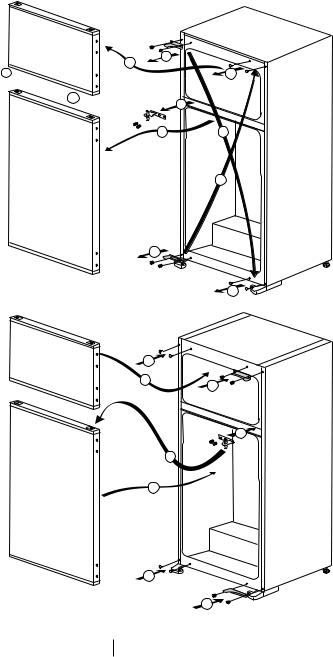
Reversing the doors
Proceed in numerical order.
 4
4
2' & 2" - only 2 for Italy models. 2' 
2''
1
3
6
11
16
15
13
8
9
7
10
17
12
9EN

4 Preparation
CYour refrigerator should be installed at least 30 cm away from heat sources such as hobs, ovens, central heater and stoves and at least 5 cm away from electrical ovens and should not be located under direct sunlight.
CThe ambient temperature of the room where you install your
refrigerator should at least be 10°C. Operating your refrigerator under cooler conditions than this is not recommended with regard to its efficiency.
CPlease make sure that the interior of your refrigerator is cleaned thoroughly.
CIf two refrigerators are to be installed side by side, there should be at least 2 cm distance between them.
CWhen you operate your refrigerator for the first time, please observe the following instructions during the initial six hours.
-The door should not be opened frequently.
-It must be operated empty without any food in it.
-Do not unplug your refrigerator. If a power failure occurs out of your control, please see the warnings in the “Recommended solutions for the problems” section.
COriginal packaging and foam materials should be kept for future transportations or moving.
10 EN
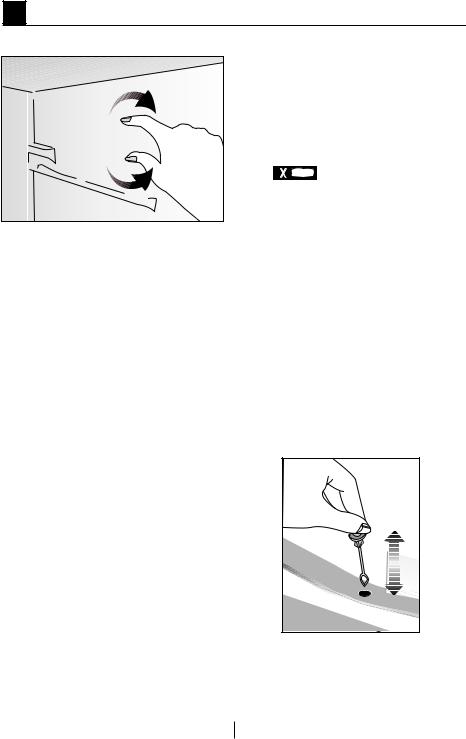
5 Using your refrigerator
Thermostat setting button
The interior temperature of your refrigerator changes forthe following reasons:
•Seasonal temperatures.
•Frequent opening of the door and leaving the door open for long periods.
•Food put into the refrigerator without cooling down to the room temperature.
•The location of the refrigerator in the room (e.g. exposing to sunlight).
•You may adjust the varying interior temperature due to such reasons by using the thermostat. Numbers around the thermostat button indicates the cooling degrees.
•If the ambient temperature is higher than 32°C, turn the thermostat button to maximum position.
•If the ambient temperature is lower than 25°C, turn the thermostat button to minimum position.
Cooling
Food storage
The fridge compartment is for the short-term storage of fresh food and drinks.
Freezing
Freezing food
The freezing compartment is marked with 


 this symbol.
this symbol.
You can use the appliance for freezing fresh food as well as for storing pre-frozen food.
Please refer to the recommendations given on the packaging of your food.
Defrost
A) Fridge compartment
Fridge compartment performs fullautomatic defrosting.
Water resulting from the defrosting passes from the water collection groove and flows into the evaporator through the drain pipe and evaporates here by itself.
Check regularly to see if the drain pipe is clogged or not and clear it with the stick in the hole when necessary.
11 EN

B) Freezer compartment
Deep freezer compartment doesnot perform automatic defrosting in order to prevent decaying of the frozen food.
Frost formation in the freezer compartment must be defrosted every 6 months. It is recommended to defrost the ice when the deep freezer compartment is not filled too much or is empty. To do this, wrap the frozen food by paper and keep them in the coolest place possible or in another refrigerator if available. Stop your refrigerator by means of the temperature setting button or unplug the power cord from the outlet. You can place a container filled with hot water into the freezer compartment or leave the door of the freezer compartment open in order to hasten the defrosting. Remove the water that accumulates in the freezer compartment with an absorbent cloth or sponge. Dry the freezer compartment completely and return the temperature setting button to its previous position. Operate your refrigerator for 2 hours while it is empty and its doors are closed before replacing your food into the deep freezer.
Stopping your product
If your thermostat is equipped with “0” position:
-Your product will stop operating when you turn the thermostat button to “0” (zero) position. Your product will not start unless to you turn the thermostat button to position “1” or one of the other positions again.
If your thermostat is equipped with “min” position:
-Unplug your product to stop it.
Ice making
Fill the ice container with water and place it into its seat. Your ice will be ready approximately in two hours.
You can easily remove your iceby slightly twisting the ice container.
12 EN

6 Maintenance and cleaning
A Never use gasoline, benzene or similar substances for cleaning purposes.
B We recommend that you unplug the appliance before cleaning.
B
ANever use cleaning agents or water that contain chlorine to clean the outer surfaces and chromium coated parts of the product. Chlorine causes corrosion on such metal surfaces.
CUse lukewarm water to clean the cabinet of your refrigerator and wipe it dry.
CUse a damp cloth wrung out in a solution of one teaspoon of
bicarbonate of soda to one pint of water to clean the interior and wipe it dry.
B Make sure that no water enters the lamp housing and other electrical items.
B If your refrigerator is not going to be used for a long period of time, unplug the power cable, remove all food, clean it and leave the door ajar.
CCheck door seals regularly to ensure they are clean and free from food particles.
A To remove door racks, remove all the contents and then simply push the door rack upwards from the base.
Protection of plastic surfaces
CDo not put the liquid oils or oil-cooked meals in your refrigerator in unsealed containers as they damage the plastic surfaces of your refrigerator. In case of spilling or smearing oil on the plastic surfaces, clean and rinse the relevant part of the surface at once with warm water.
13 EN

7 Recommended solutions for the problems
Please review this list before calling the service. It might save you time and money. This list includes frequent complaints that are not arising from defective workmanship or material usage. Some of the features described here may not exist in your product.
The refrigerator does not operate.
•Is the refrigerator properly plugged in? Insert the plug to the wall socket.
•Is the fuse of the socket which your refrigerator is connected to or the main fuse blown out? Check the fuse.
Condensation on the side wall of the fridge compartment (MULTIZONE, COOL CONTROL and FLEXI ZONE).
•Very cold ambient conditions. Frequent opening and closing of the door. Highly humid ambient conditions. Storage of food containing liquid in open containers. Leaving the door ajar. Switching the thermostat to a colder degree.
•Decreasing the time the door left open or using it less frequently.
•Covering the food stored in open containers with a suitable material.
•Wipe the condensation using a dry cloth and check if it persists.
Compressor is not running.
•Protective thermic of the compressor will blow out during sudden power failures or plug-out plug-ins as the refrigerant pressure in the cooling system of the refrigerator has not been balanced yet. Your refrigerator will start running approximately after 6 minutes. Please call the service if the refrigerator does not startup at the end of this period.
•The fridge is in defrost cycle. This is normal for a full-automatically defrosting refrigerator. Defrosting cycle occurs periodically.
•Your refrigerator is not plugged into the socket. Make sure that the plug is properly fit into the socket.
•Are the temperature adjustments correctly made?
•Power might be cut off.
14 EN

The fridge is running frequently or for a long time.
•Your new product may be wider than the previous one. This is quite normal. Large refrigerators operate for a longer period of time.
•The ambient room temperature may be high. This is quite normal.
•The refrigerator might have been plugged in recently or might have been loaded with food. Cooling down of the refrigerator completely may last for a couple of hours longer.
•Large amounts of hot food might have been put in the refrigerator recently. Hot food causes longer running of the refrigerator until they reach the safe storage temperature.
•Doors might have been opened frequently or left ajar for a long time. The warm air that has entered into the refrigerator causes the refrigerator to run for longer periods. Open the doors less frequently.
•Freezer or fridge compartment door might have been left ajar. Check if the doors are tightly closed.
•The refrigerator is adjusted to a very low temperature. Adjust the refrigerator temperature to a warmer degree and wait until the temperature is achieved.
•Door seal of the fridge or freezer may be soiled, worn out, broken or not properly seated. Clean or replace the seal. Damaged/broken seal causes the refrigerator to run for a longer period of time in order to maintain the current temperature.
Freezer temperature is very low while the fridge temperature is sufficient.
•The freezer temperature is adjusted to a very low temperature. Adjust the freezer temperature to a warmer degree and check.
Fridge temperature is very low while the freezer temperature is sufficient.
•The fridge temperature might have been adjusted to a very low temperature. Adjust the fridge temperature to a warmer degree and check.
Food kept in the fridge compartment drawers are freezing.
•The fridge temperature might have been adjusted to a very low temperature. Adjust the fridge temperature to a warmer degree and check.
Temperature in the fridge or freezer is very high.
•The fridge temperature might have been adjusted to a very high degree. Fridge adjustment has an effect on the temperature of the freezer. Change the
temperature of the fridge or freezer until the fridge or freezer temperature reaches to a sufficient level.
•Doors might have been opened frequently or left ajar for a long time; open them less frequently.
•Door might have been left ajar; close the door completely.
•Large amount of hot food might have been put in the refrigerator recently. Wait until the fridge or freezer reaches the desired temperature.
•The refrigerator might have been plugged in recently. Cooling down of the refrigerator completely takes time.
15 EN
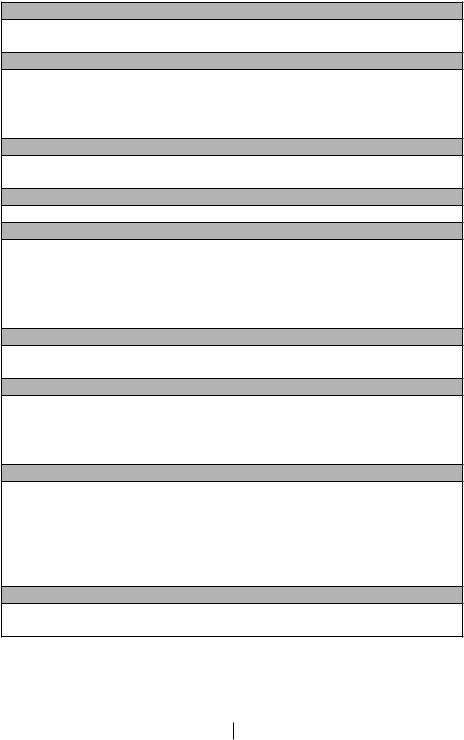
The operation noise increases when the refrigerator is running.
•The operating performance of the refrigerator may change due to the changes in the ambient temperature. It is normal and not a fault.
Vibrations or noise.
•The floor is not even or it is weak. The refrigerator rocks when moved slowly. Make sure that the floor is strong enough to carry the refrigerator, and level.
•The noise may be caused by the items put onto the refrigerator. Items on top of the refrigerator should be removed.
There are noises coming from the refrigerator like liquid spilling or spraying.
•Liquid and gas flows happen in accordance with the operating principles of your refrigerator. It is normal and not a fault.
There is a noise like wind blowing.
•Fans are used in order to cool the refrigerator. It is normal and not a fault. Condensation on the inner walls of refrigerator.
•Hot and humid weather increases icing and condensation. It is normal and not a fault.
•Doors might have been left ajar; make sure that the doors are closed fully.
•Doors might have been opened frequently or left ajar for a long time; open them less frequently.
Humidity occurs on the outside of the refrigerator or between the doors.
•There might be humidity in the air; this is quite normal in humid weather. When the humidity is less, condensation will disappear.
Bad odour inside the refrigerator.
•Inside of the refrigerator must be cleaned. Clean the inside of the refrigerator with a sponge, lukewarm water or carbonated water.
•Some containers or package materials might cause the smell. Use a different container or different brand packaging material.
The door is not closing.
•Food packages may prevent the door's closing. Replace the packages that are obstructing the door.
•The refrigerator is not completely upright on the floor and rocking when slightly moved. Adjust the elevation screws.
•The floor is not level or strong. Make sure that the floor is level and capable to carry the refrigerator.
Crispers are stuck.
•The food might be touching the ceiling of the drawer. Rearrange food in the drawer.
16 EN
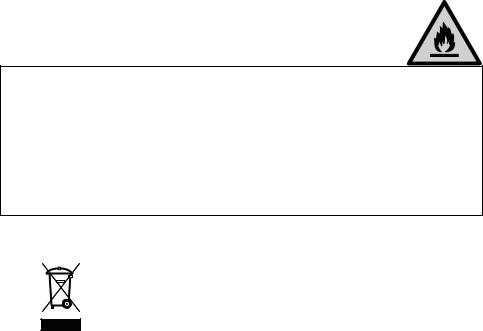
Leggere innanzitutto il manuale di istruzioni.
Gentile Cliente,
ci auguriamo che l'articolo da Lei scelto, prodotto in moderni stabilimenti e sottoposto ai più severi controlli di qualità, risponda interamente alle Sue esigenze.
A tal fine, La invitiamo a leggere attentamente il manuale di istruzioni del prodotto prima di procedere al suo utilizzo e di conservarlo per eventuali consultazioni future.
Il presente manuale
•Aiuterà l'utente ad utilizzare l'apparecchio in modo rapido e sicuro.
•Leggere le istruzioni per l'uso prima di installare e utilizzare il prodotto.
•Seguire attentamente le istruzioni, in particolare quelle inerenti alla sicurezza.
•Conservare il presente manuale in un luogo facilmente accessibile per eventuali future consultazioni.
•Leggere inoltre gli altri documenti forniti assieme al prodotto.
Il presente manuale può essere valido anche per altri modelli.
Simboli e loro descrizione
Il manuale di istruzioni contiene i seguenti simboli: C Informazioni importanti o consigli utili di utilizzo.
A Segnale di avvertimento in caso di situazioni pericolose per la persona o i beni. B Avvertimento in caso di problemi con il voltaggio.
AVVERTENZA!
Per garantire il funzionamento adeguato dell'elettrodomestico, che utilizza il refrigerante R600a completamente adatto all'ambiente (infiammabile solo in determinate condizioni), è necessario attenersi alle seguenti regole:
• Non ostacolare la libera circolazione dell'aria attorno all'elettrodomestico.
• Per accelerare lo sbrinamento non utilizzare dispositivi meccanici diversi da quelli consigliati dal produttore.
• Non danneggiare il circuito refrigerante.
• Non utilizzare all'interno del comparto del cibo elettrodomestici diversi da quelli consigliati dal produttore.
Questo prodotto riporta il simbolo di raccolta differenziata per le Riciclaggio apparecchiature elettriche ed elettroniche di rifiuto (WEEE).
Ciò significa che il prodotto deve essere gestito in conformità alla
direttiva europea 2002/96/EC in modo che durante il riciclaggio e lo smontaggio sia ridotto al minimo l’impatto sull’ambiente. Per ulteriori
informazioni contattare le autorità locali o regionali.
I prodotti elettronici non inclusi nel processo di raccolta differenziata sono potenzialmente pericolosi per l’ambiente e la salute umana a causa della presenza di sostanze pericolose.

INDICE
1 Il frigorifero 3 4 Preparazione 10
Importanti avvertenze per |
|
la sicurezza |
4 |
Uso previsto ...................................... |
4 |
Sicurezza generale ............................ |
4 |
Sicurezza bambini ............................. |
6 |
Avvertenza HCA ................................ |
6 |
Cose da fare per risparmiare energia... |
6 |
5 Utilizzo del frigorifero |
11 |
Tasto di impostazione termostato |
....11 |
Raffreddamento .............................. |
11 |
Congelamento ................................. |
11 |
Sbrinamento ................................... |
11 |
Arresto del prodotto ........................ |
12 |
Preparazione ghiaccio ..................... |
12 |
3 Installazione |
7 |
Punti da tenere in considerazione |
|
quando si trasporta nuovamente il |
|
frigorifero .......................................... |
7 |
Prima di utilizzare il frigorifero ............ |
7 |
Collegamento elettrico ...................... |
7 |
Smaltimento del materiale di |
|
imballaggio ....................................... |
8 |
Smaltimento del vecchio frigorifero ... |
8 |
Posizionamento e installazione ......... |
8 |
Sostituzione della lampadina interna... |
8 |
Inversione degli sportelli.................... |
9 |
6 Manutenzione e pulizia 13 rotezione delle superfici di plastica 13
7 Soluzioni consigliate per i
problemi |
14 |
2IT
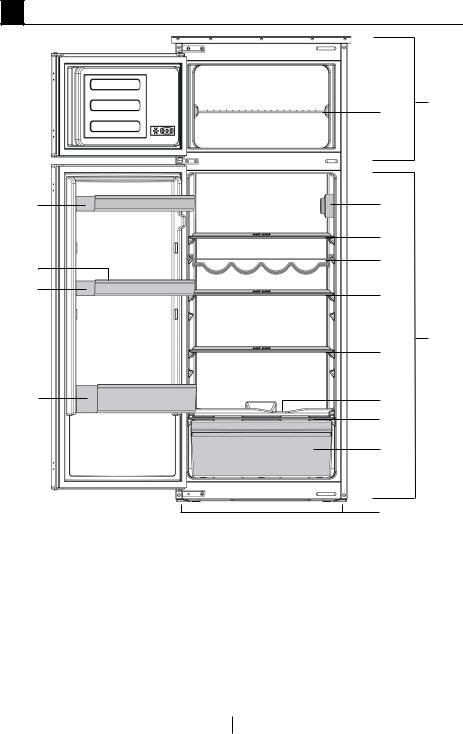
1 Il frigorifero
9
10
9
11
1.Ripiano freezer
2.Alloggiamento del termostato e della spia
3.Ripiani comparto frigo
4.Mensola vino
5.Canale di raccolta dell'acqua di sbrinamento - tubo di drenaggio
6.Coperchio scomparto frutta e verdura
7.Scomparto insalata
12
1
2
3
4
3
13
3
5
6
7
8
8.Piedini anteriori
9.Scomparti della controporta
10.Scomparto perle uova
11.Ripiano bottiglie
12.Scomparto freezer
13.Scomparto frigo
CLe illustrazioni contenute in questa guida sono schematiche e potrebbero non corrispondere esattamente al prodotto in uso. Se le parti in oggetto non sono incluse nel prodotto acquistato, significa che sono da intendersi per altri modelli.
3IT

2 Importanti avvertenze per la sicurezza
Prendere in esame le seguenti informazioni. Se queste informazioni non vengono rispettate, possono verificarsi lesioni personali o danni materiali. Quindi tutte le garanzie e gli impegni sull’affidabilità diventerebbero privi di validità.
I pezzi di ricambio originali verranno forniti per 10 anni, successivamente
alla data di acquisto del prodotto.
Uso previsto
•Questo apparecchio è destinato ad un uso domesticoe applicazioni simili come:
•aree destinate acucinain negozi, uffici e altri ambientidi lavoro;
•fattorie edaclientiin alberghi, motel e altri ambienti ditipo residenziale;
•ambienti tipobedand breakfast;
•cateringe simili applicazioni non commerciali.
•Nondeve essere usato all’esterno. L’uso esterno nonè appropriato anchese coperto daun tetto.
Sicurezza generale
•Quando si vuole smaltire/eliminare l'apparecchio, è consigliabile consultare il servizio autorizzato per apprendere le informazioni necessarie e conoscere gli enti autorizzati.
•Consultare il servizio di manutenzione autorizzato per tutti i problemi relativi al frigorifero. Non intervenire o far intervenire sul frigorifero senza informare il servizio manutenzione autorizzato.
•Non mangiare coni gelati ghiacciati p cubetti di ghiaccio o gelati appena presi dal freezer! (possono provocare bruciature da freddo alla bocca). (Ciò potrebbe causare sintomi di congelamento in bocca).
•Non mettere bottiglie e lattine di bibite liquide nello scomparto del freezer altrimenti potrebbero esplodere.
•Non toccare con le mani gli alimenti gelati; possono incollarsi ad esse.
•Il vapore e i materiali per la pulizia vaporizzati non devono mai essere usati per pulire e scongelare il frigorifero. In questo caso il vapore può entrare in contatto con le parti elettriche e provocare corto circuito o scossa elettrica.
•Non usare mai parti del frigorifero come lo sportello come mezzo di supporto o movimento.
•Non utilizzare dispositivi elettrici all’interno del frigorifero.
•Non danneggiare il circuito di raffreddamento, in cui circola il refrigerante, con utensili perforanti o taglienti. Il refrigerante può scoppiare quando i canali del gas
dell’evaporatore, le estensioni dei tubi o le pellicole superficiali vengono punti e possono provocare irritazioni alla pelle e lesioni agli occhi.
•Non bloccare o coprire la ventilazione dell’elettrodomestico.
•Le riparazioni agli apparecchi elettrici devono essere eseguite solo da personale qualificato. Le riparazioni eseguite da personale non competente possono provocare danni all’utilizzatore.
•In caso di guasto o durante lavori di riparazione e manutenzione, scollegare la fornitura d'energia principale spegnendo il fusibile principale o scollegando la presa dell’apparecchio.
•Non tirare dal cavo quando si estrae la spina.
•Posizionare le bibite più alte molto vicine e in verticale.
•Non conservare sostanze esplosive come aerosol con gas propellenti infiammabili nell'apparecchio.
•Non utilizzare apparecchiature meccaniche o altri mezzi diversi da quelli consigliati dal produttore, per accelerare il processo di sbrinamento.
4IT

•Questo apparecchio non deve essere usato da persone (compresi bambini) con capacità fisiche, sensoriali o mentali ridotte, o mancanza di esperienza e conoscenza, a meno che non ricevano la supervisione o le istruzioni per l’uso dell’apparecchio da parte di una persona responsabile della loro sicurezza.
•Non utilizzare frigoriferi danneggiati. Consultare il servizio assistenza in caso di dubbi.
•La sicurezza elettrica del frigorifero è garantita unicamente se il sistema di messa a terra dell’apparecchiatura è conforme agli standard.
•L’esposizione del prodotto a pioggia, neve, sole e vento è pericolosa per la sicurezza elettrica.
•Contattare l’assistenza autorizzata quando ci sono danni ai cavi ecc., in modo che non creino pericoli per l’utente.
•Non collegare mai il frigorifero alla presa a muro durante l’installazione, per evitare il rischio di morte o lesioni gravi.
•Questo frigorifero è destinato solo alla conservazione di alimenti. Non deve essere usato per altri fini.
•L'etichetta che descrive le specifiche tecniche del prodotto si trova a sinistra nella parte interna del frigorifero.
•Non collegare il frigorifero a sistemi di risparmio energetico poiché possono danneggiare l'apparecchio.
•Se il frigorifero presenta una luce blu, non guardarla usando dispositivi ottici.
•Se l'alimentazione è scollegata negli apparecchi controllati manualmente, attendere almeno 5 minuti prima di ricollegarla.
•Questo manuale deve essere trasferito al successivo proprietario del frigorifero, in caso di passaggio di proprietà.
•Quando si sposta l'apparecchio, assicurarsi di non danneggiare il cavo di alimentazione. Per evitare che il cavo di alimentazione si incendi, evitare di torcerlo. Non mettere oggetti pesanti sul cavo di alimentazione. Quando il frigorifero viene collegato alla rete, non toccare la presa di alimentazione con le mani bagnate.
•Non collegare il frigorifero alla rete se la presa elettrica è allentata.
•Non far schizzare l'acqua direttamente sulle parti esterne o interne del frigorifero per ragioni di sicurezza.
•Non spruzzare materiali infiammabili come gas propano, ecc. nelle vicinanze del frigorifero, a causa del rischio di incendio ed esplosioni.
•Non mettere oggetti pieni di acqua sopra al frigorifero poiché potrebbero provocare uno shock elettrico o un incendio.
•Non sovraccaricare il frigorifero con troppi alimenti. Gli alimenti in eccesso possono cadere quando viene aperto lo sportello, causando lesioni alla persona o danneggiando il frigorifero.
•Non mettere oggetti sopra al frigorifero poiché potrebbero cadere quando si apre o si chiude lo sportello dell'apparecchio.
•Materiali che richiedono determinate condizioni di temperatura come vaccini, farmaci termosensibili, materiali scientifici, ecc. non devono essere tenuti in frigorifero.
•Se il frigorifero non viene usato per molto tempo, deve essere scollegato dalla rete. Un problema nell'isolamento del cavo elettrico potrebbe provocare un incendio.
5IT

•La punta della spina elettrica deve essere regolarmente pulita altrimenti potrebbe provocare un incendio.
•La punta della spina deve essere pulita regolarmente con un panno asciutto; altrimenti può provocare un incendio.
•Il frigorifero potrebbe spostarsi quando i piedini regolabili non sono posizionati in modo fermo a terra. Usando i piedini regolabili si assicura che il frigorifero sia posizionato in modo stabile sul pavimento.
•Se il frigorifero ha una maniglia sullo sportello, non tirare l'apparecchio dalla maniglia quando lo si sposta, altrimenti la maniglia potrebbe staccarsi.
•Se è necessario utilizzare l’apparecchio vicino ad un altro frigorifero o un altro freezer, la distanza tra gli apparecchi deve essere almeno 8 cm. Altrimenti si può creare condensa sulle pareti laterali che sono l’una di fronte all’altra.
•La pressione principale dell’acqua non deve scendere sotto 1 bar. La pressione principale dell’acqua non deve essere superiore a 8 bar.
•Usare solo acqua potabile.
Sicurezza bambini
•Se la porta ha un lucchetto, la chiave deve essere tenuta lontana dalla portata dei bambini.
•I bambini devono ricevere la supervisione necessaria ad assicurare che non giochino con l’apparecchio.
Avvertenza HCA
Se il prodotto è dotato di un sistema di raffreddamento che contiene R600a:
Questo gas è infiammabile. Pertanto, fare attenzione a non danneggiare il sistema di raffreddamento e le tubazioni durante l’uso e il trasporto. In caso di danni, tenere il prodotto lontano da potenziali fonti di incendio che possono provocarne l’incendio e ventilare la stanza in cui si trova l'unità.
Ignorare l’avvertenza se il prodotto è dotato di un sistema di
raffreddamento che contiene R134a.
Si può vedere il gas usato nella produzione del dispositivo sull'etichetta informativa ch si trova nella parte interna sinistra dello stesso.
Non gettare mai il prodotto nel fuoco.
Cose da fare per risparmiare energia
•Non lasciare lo sportello del frigorifero aperto per lungo tempo.
•Non inserire cibo caldo o bevande calde nell'elettrodomestico.
•Non sovraccaricare il frigorifero impedendo la circolazione dell’aria al suo interno.
•Non installare il frigorifero sotto la luce diretta del sole o nelle vicinanze di forni, lavastoviglie o radiatori.
•Porre attenzione nel conservare il cibo in contenitori chiusi.
•La quantità massima di alimenti può essere posta nello scomparto freezer del frigorifero quando il ripiano o il cassetto dello scomparto freezer sono rimossi. Il valore di consumo energetico dichiarato per il frigorifero è stato stabilito con il ripiano o il cassetto dello scomparto freezer rimossi e con la quantità massima di alimenti caricata. Non c'è rischio nell'usare un ripiano o un cassetto secondo le forme e le dimensioni degli alimenti da congelare.
6IT

3 Installazione
B Ricordarsi che il fabbricante non è responsabile della mancata
osservanza delle informazioni fornite nel manuale di istruzioni.
Punti da tenere in considerazione quando si trasporta nuovamente il frigorifero
1.Deve essere svuotato prima di ogni trasporto.
2.Scaffali, accessori, cestelli ecc. devono essere fissati nel frigorifero in modo sicuro per mezzo di nastro adesivo prima di essere di nuovo imballati.
3.L’imballaggio deve essere eseguito con nastro spesso e forte e le norme di trasporto devono
essere scrupolosamente seguite.
Cose da non dimenticare…
Tutti i materiali riciclati sono una fonte indispensabile per la natura e per le nostre risorse naturali.
Se si vuole contribuire al riciclaggio di materiali da imballo, è necessario rivolgersi per ulteriori informazioni alle autorità locali per l’ambiente.
Prima di utilizzare il frigorifero
Prima di avviare l’uso del frigorifero, controllare quanto segue:
1.L’interno del frigorifero è asciutto e l’aria può circolare liberamente sul retro?
2.Pulire la parte interna del frigorifero come consigliato nella sezione "Manutenzione e pulizia".
3.Collegare il frigorifero alla presa a muro. Quando lo sportello del
frigorifero viene aperto si accenderà la luce interna allo scomparto frigo.
4.Si sente un rumore quando il compressore si avvia. I liquidi e i gas sigillati nel sistema refrigerante possono produrre dei rumori, anche se il compressore non è in funzione; questo è abbastanza normale.
5.I bordi anteriori del frigorifero possono essere tiepidi. Questo è normale. Queste zone sono progettate
per essere tiepide per evitare la condensazione.
Collegamento elettrico
Collegare il frigorifero ad una presa di messa a terra protetta da un fusibile della capacità appropriata. Importante:
•Il collegamento deve essere conforme ai regolamenti nazionali.
•Il cavo di alimentazione deve essere facilmente accessibile dopo l’installazione.
•La tensione specificata deve essere pari a quella di rete.
•Le prolunghe e le prese multiple non devono essere usate per il collegamento.
B Un cavo di alimentazione danneggiato deve essere sostituito da un elettricista qualificato.
B L’apparecchio non deve essere usato finché non viene riparato! C’è pericolo di shock elettrico!
7IT

Smaltimento del materiale di imballaggio
I materiali di imballaggio potrebbero essere dannosi per i bambini. Tenere i materiali di imballaggio fuori dalla portata dei bambini o smaltirli classificandoli secondo le istruzioni sui rifiuti. Non smaltirli insieme ai normali rifiuti domestici.
L’imballaggio del frigorifero è prodotto con materiali riciclabili.
Smaltimento del vecchio frigorifero
Smaltimento del vecchio frigorifero senza danni per l’ambiente.
•Bisogna consultare il rivenditore autorizzato o il centro di raccolta rifiuti della propria città per quanto riguarda
lo smaltimento del frigorifero.
Prima di smaltire il frigorifero, tagliare la spina elettrica e, se ci sono blocchi allo sportello, renderli inutilizzabili per proteggere i bambini da eventuali pericoli.
Posizionamento e installazione
A Nel caso in cui la porta di ingresso della stanza in cui il frigorifero deve
essere posizionato non è abbastanza grande per il passaggio del frigorifero, chiamare il servizio autorizzato per rimuovere le porte del frigorifero e per farlo passare attraverso la porta.
1.Installare il frigorifero in un luogo che ne permetta il facile utilizzo.
2.Tenere il frigorifero lontano da fonti di calore, luoghi umidi e luce diretta del
sole.
3.Intorno al frigorifero deve esserci ventilazione appropriata per poter avere operatività efficiente. Se il frigorifero deve essere posizionato in un recesso della parete, è necessario porlo ad almeno 5 cm di distanza dal soffitto e a 5 cm dalla parete. Se il pavimento è coperto con un tappeto, il prodotto deve essere sollevato di 2,5 cm dal pavimento.
4.Posizionare l'elettrodomestico solo su superfici uniformi e piane per evitare dondolii.
5.Non tenere il frigorifero in ambienti con temperature inferiori ai 10°C.
Sostituzione della lampadina interna
Per cambiare lampadina/LED utilizzati per illuminare il frigorifero, rivolgersi al Servizio Assistenza Autorizzato.
La lampada (le lampade usata (usate nell'apparecchiatura non è (sono adatta (adatte per l'illuminazione domestica. L'obiettivo previsto per questa lampada è quello di assistere l'utente in fase di posizionamento degli alimenti all'interno del frigorifero / congelatore in modo
sicuro e comodo. Le lampadine utilizzate in questo apparecchio devono
sopportare condizioni fisiche estreme come temperature inferiori a -20°C.
8IT
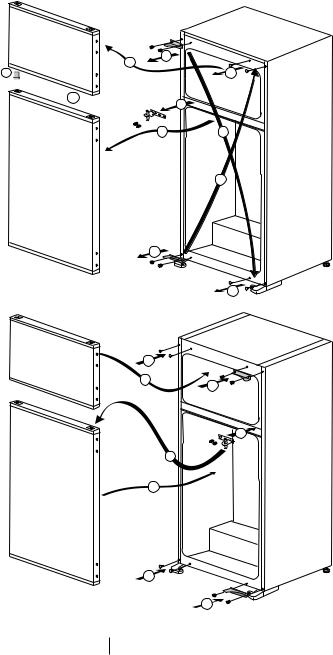
Inversione degli sportelli
Procedere in ordine numerico.
2' e 2" - solo per |
2 |
4 |
|
||
2' |
|
|
i modelli italiani. |
|
|
2'' |
1 |
|
|
|
3 |
6
11
16
15
13
8
9
7
10
17
12
9IT

4 Preparazione
CIl frigorifero dovrà essere installato ad almeno 30 cm lontano da fonti di calore, come forni, riscaldamento centrale e stufe e ad almeno 5 cm da forni elettrici e non deve essere esposto alla luce diretta del sole.
CLa temperatura ambiente della stanza in cui viene installato il frigorifero
deve essere almeno 10°C . Usare il frigorifero in ambienti con temperatura inferiore non è consigliabile per motivi di efficienza.
CAssicurarsi che l’interno del frigorifero sia ben pulito.
CIn caso di installazione di due frigoriferi l’uno accanto all’altro, devono esservi almeno 2 cm di distanza tra di loro.
CQuando il frigorifero viene messo in funzione per la prima volta, osservare le seguenti istruzioni per le prime sei ore.
-La porta non si deve aprire frequentemente.
-Deve funzionare vuoto senza alimenti all’interno.
-Non staccare il frigo dalla presa di corrente. Se si verifica un calo di potenza al di là del controllo dell'utente, vedere le avvertenze nella sezione “Soluzioni consigliate per i problemi”.
CConservare i materiali originali di imballaggio per futuri trasporti o spostamenti.
10 IT

5 Utilizzo del frigorifero
Tasto di impostazione termostato
La temperatura interna del frigorifero cambia per le seguenti cause:
•Temperature stagionali.
•Apertura frequente dello sportello e sportello lasciato aperto per lunghi periodi.
•Alimenti messi nel frigorifero senza lasciarli prima raffreddare a temperatura ambiente.
•Posizionamento del frigorifero nella stanza (per esempio, esposizione alla luce solare).
•Qualora si verifichino le suddette situazioni, è possibile adattare la temperatura interna del frigorifero utilizzando il termostato. I numeri riportati intorno al tasto indicano i gradi di raffreddamento.
•Se la temperatura ambiente è superiore ai 32°C, ruotare il tasto del termostato fino al punto massimo.
•Se la temperatura ambiente è inferiore ai 25°C, ruotare il tasto del termostato fino al punto minimo.
Raffreddamento
Conservazione alimenti
Lo scomparto frigo serve per la conservazione a breve termine di cibi freschi e bevande.
Congelamento
Congelamento alimenti
Il comparto freezer è segnalato da questo simbolo  .
.
È possibile usare l'elettrodomestico per congelare cibi freschi ma anche per conservare cibi pre-congelati.
Vedere i consigli presenti sulle confezioni degli alimenti.
Sbrinamento
A) Scomparto frigo
Lo scomparto frigo effettua
l'operazione di sbrinamento in modo totalmente automatico. L’acqua che
viene prodotta dallo sbrinamento passa per la scanalatura di raccolta dell’acqua e fluisce nell’evaporatore attraverso il tubo di scarico e da lì evapora.
Controllare regolarmente per vedere se il tubo di evaporazione è bloccato o meno, e pulirlo con il bastoncino nel foro, quando necessario.
11 IT
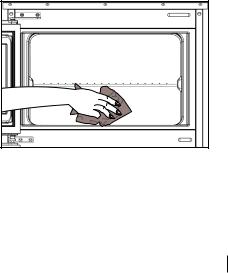
B) Scomparto freezer
Lo scomparto del surgelatore non effettua operazioni di sbrinamento automatico per evitare di compromettere l'integrità dei cibi congelati. Il ghiaccio che si forma nel comparto freezer deve essere eliminato ogni sei mesi. Si raccomanda di eliminare il ghiaccio quando lo scomparto del surgelatore non è né troppo pieno né vuoto. Per farlo, avvolgere gli alimenti congelati nella carta e tenerli nel posto più freddo possibile o in un altro frigo se disponibile. Arrestare il frigorifero con la manopola di impostazione della temperatura o staccando il cavo di alimentazione dalla presa. Si può mettere un contenitore pieno d'acqua
calda nel comparto freezer lasciarne aperta la porta per affrettare lo
scongelamento. Rimuovere l'acqua che si accumula nel comparto freezer con un panno assorbente o una spugna. Asciugare completamente il comparto freezer e riportare il tasto di impostazione della temperatura alla posizione precedente.
Prima di rimettere gli alimenti nel comparto surgelati, far funzionare il frigorifero per 2 ore vuoto e con le porte chiuse.
Arresto del prodotto
Se il termostato è dotato della posizione “0”:
-Il prodotto smette di funzionare quando si porta il termostato in posizione “0” (zero). Il prodotto non si avvia a meno che non si porta di nuovo il termostato in posizione “1” o un'altra posizione.
Se il termostato è dotato della posizione “min”:
-Scollegare il prodotto per arrestarlo.
Preparazione ghiaccio
Riempire il contenitore del ghiaccio con acqua e metterlo in sede. Il ghiaccio sarà pronto in due ore circa.
È possibile rimuovere facilmente il ghiaccio torcendo leggermente il contenitore del ghiaccio.
12 IT
